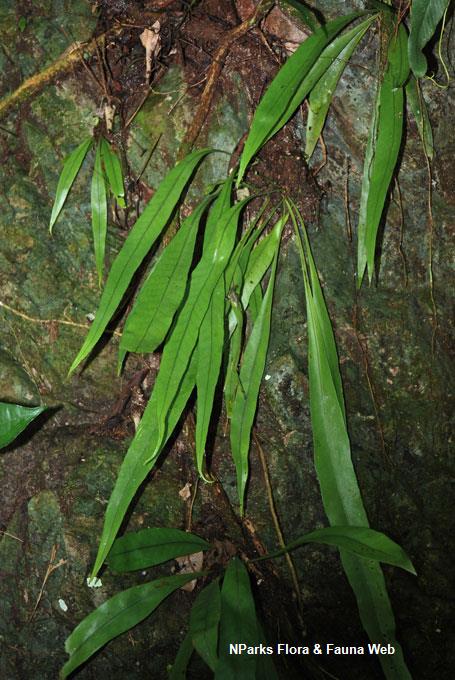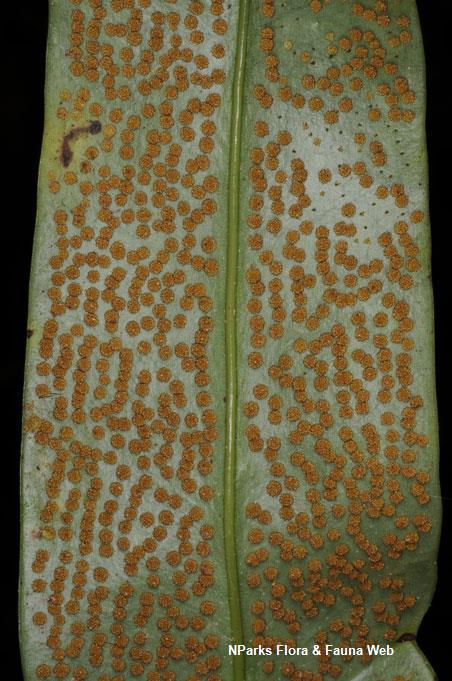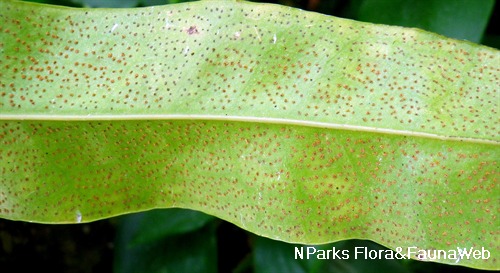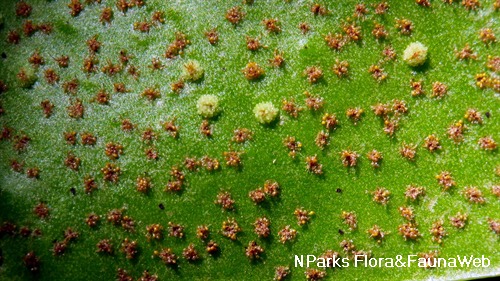
Back
Microsorum punctatum (L.) Copel.
| Family Name: | Polypodiaceae |
| Synonyms: | Polypodium polycarpon Cav., Pleopeltis punctata (L.) Bedd., Pleopeltis irioides T.Moore |
| Common Name: | Fishtail Fern, Crested Fern, Keluwah, 星蕨 |
Microsorum punctatum or Fishtail Fern is a fern native to Singapore. The Fishtail Fern can be found growing as an epiphyte, terrestrial plant or on surfaces of rocks. The simple fronds are leathery, produced closely together along the short-creeping rhizomes covered in lattice-like, spoon to triangular-shaped scales. Sori are small, round, scattered along the veinlets on the underside.
Name
Classifications and Characteristics
| Plant Division | Ferns & Lycophytes (Non-Seed Vascular Plants) (Fern) |
|---|---|
| Plant Growth Form | Epiphyte, Lithophyte, Herbaceous Plant |
| Lifespan (in Singapore) | Perennial |
| Mode of Nutrition | Autotrophic |
Biogeography
| Native Distribution | Tropical Africa and Asia, and Subtropics |
|---|---|
| Native Habitat | Terrestrial (Primary Rainforest, Inland Cliff, Agricultural Land, Secondary Rainforest, Disturbed Area / Open Ground) |
| Preferred Climate Zone | Tropical, Sub-Tropical / Monsoonal |
| Local Conservation Status | Native to Singapore (Least Concern (LC)) |
Description and Ethnobotany
| Growth Form | It is a fern with short-creeping rhizomes, can be found as an epiphyte, terrestrial plant or grown on surfaces of rocks. |
|---|---|
| Foliage | Fronds are produced close together, thick, leathery, narrowly egg-shaped, elliptic, spoon to lance-shaped, variable in length up to 1.75 m long, 15 cm wide. The mid rib is raised on both surfaces of the fronds. The edge of the foliage vary from smooth, wavy or irregularly lobed. |
| Reproductive Parts - non-flowering plant | The sori are small, round, scattered along the veinlets on the underside, measuring 0.2 - 0.5 cm wide. |
| Others - Plant Morphology | The rhizomes are slender, short-creeping covered in lattice-like scales. The scales are spoon-shaped to triangular shaped, measuring 1.5 - 8 mm long by 0.5 - 3 mm wide. |
| Habitat | Occurs in various types of forest, sometimes in savannah but also in wet places in streambeds, altitude to 2800 m. <1,2> |
| Etymology | Genus Microsorum refers to the small-sized sori. Species punctatum means "with a pock-marked surface or spotted". |
Landscaping Features
| Landscape Uses | Parks & Gardens, Small Gardens, Skyrise / Balcony, Interiorscape/ Indoor Plant, Container Planting, Suitable for Hanging Baskets |
|---|---|
| Thematic Landscaping | Naturalistic Garden |
Fauna, Pollination and Dispersal
| Seed or Spore Dispersal | Abiotic |
|---|
Plant Care and Propagation
| Light Preference | Semi-Shade, Full Shade, [Remarks] (Does best if grown in semi shade, but will tolerate being grown in full sun, or in heavily shaded areas) |
|---|---|
| Water Preference | Moderate Water, Little Water, [Remarks] (This species is able to tolerate short periods of drought / dryness at the root zones, but will thrive in areas with good humidity and/or moisture levels.) |
| Plant Growth Rate | Moderate |
| Rootzone Tolerance | Disease / Pest Resistant, Easy to Grow, Moist Soils, Well-Drained Soils |
| Propagation Method | Spore, Division |
Foliar
| Foliage Retention | Evergreen |
|---|---|
| Mature Foliage Colour(s) | Green - Light Green |
| Mature Foliage Texture(s) | Leathery |
| Foliar Type | Simple / Unifoliate |
| Foliar Shape(s) | Non-Palm Foliage (Elliptical, Lanceolate, Oblong, Ovate) |
| Foliar Venation | Pinnate / Net |
| Foliar Margin | Entire, Entire - Wavy / Undulate |
| Foliar Apex - Tip | Acuminate, Acute, Rounded |
| Foliar Base | Cordate, Auriculate, Attenuate |
Non - Foliar and Storage
| Stem Type & Modification | Herbaceous |
|---|---|
| Root Type | Underground (Fibrous Root) |
| Specialised Storage Organ(s) | Underground (Rhizome) |
References
| References | <1> Hovenkamp P.H. (1998). Microsorum. In: Hovenkamp, P.H. (ed.) Polypodiaceae. Flora Malesiana, ser. 2, Pteridophyta, vol. 3, pp. 121 - 123. Leiden: Rijksherbarium. <2> Tagawa, M & Iwatsuki, K. (1989). Flora of Thailand, Vol. 3(4), pp. 528-529. Bangkok: The Forest Herbarium, Department of National Parks, Wildlife and Plant Conservation. |
|---|
Image Repository
Others
| Master ID | 31534 |
|---|---|
| Species ID | 5933 |
| Flora Disclaimer | The information in this website has been compiled from reliable sources, such as reference works on medicinal plants. It is not a substitute for medical advice or treatment and NParks does not purport to provide any medical advice. Readers should always consult his/her physician before using or consuming a plant for medicinal purposes. |

.jpg)
.jpg)
.jpg)
.jpg)






.jpg)
